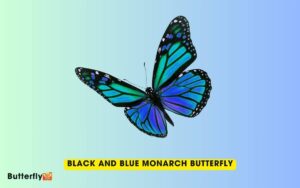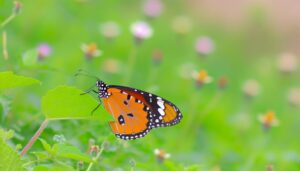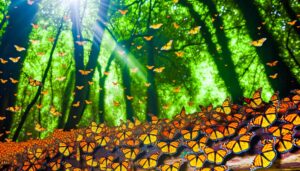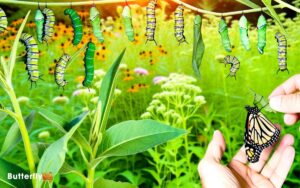How Many Monarch Butterflies Are Left? Get the Latest Facts!
You’d be alarmed to know that only around 100 million monarch butterflies are left in 2023, a significant drop from 500 million monarchs historically.
Deforestation, climate change, and pesticide use have drastically cut their numbers. Habitat loss, especially the reduction of milkweed plants, and neonicotinoid pesticides have severely impacted their population.
Temperature shifts and extreme weather also disrupt their migration and breeding cycles. Conservation efforts focus on habitat restoration and reducing pesticide use.
To understand the nuances of how these factors interplay and potential solutions, there’s more detailed information available.
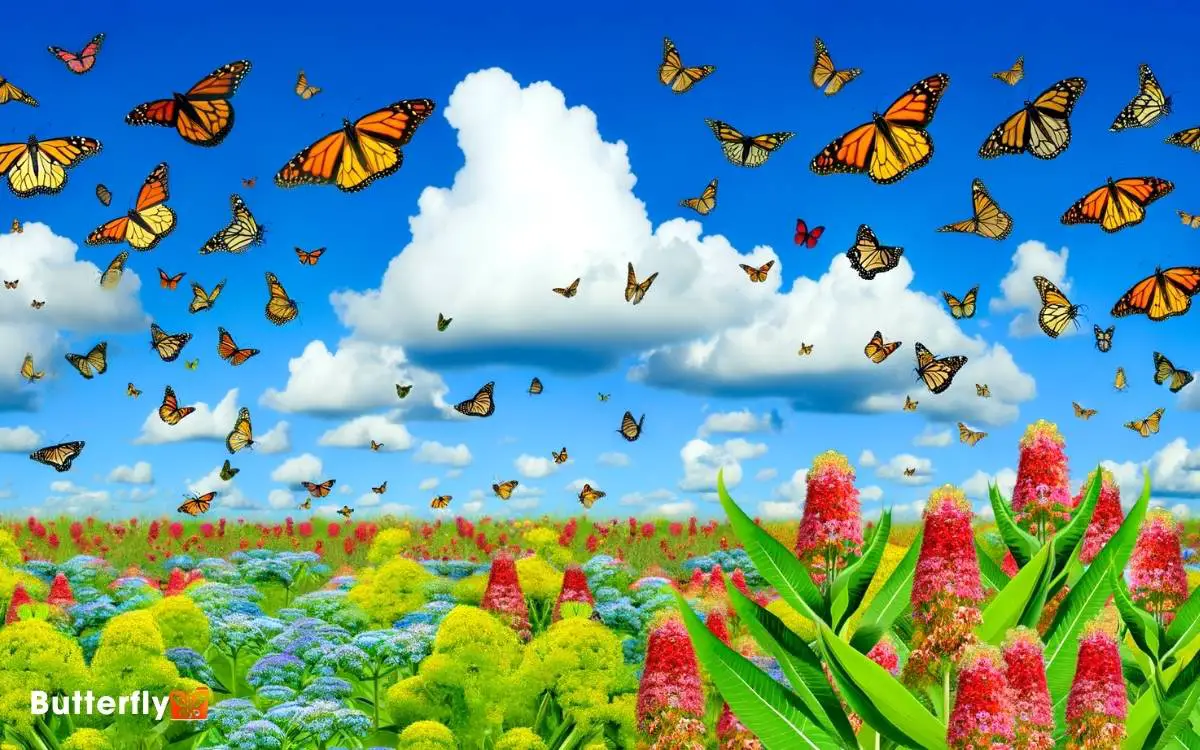
Key Takeaways
Current Population Estimates
As of the latest surveys in 2023, scientists estimate the monarch butterfly population to be around 100 million individuals. You’ll find these estimates are based on systematic counts conducted during their wintering period in Mexico.
Researchers employ a method known as ‘colony area measurement,’ where they calculate the area covered by monarch clusters in hectares. This data is then used to estimate the total population.
Each hectare of dense colonies can house approximately 20-30 million butterflies. These precise methods guarantee accurate population assessments.
However, fluctuations occur yearly due to factors like habitat loss, climate change, and predation. By understanding these estimates, you gain insight into the current state of monarch populations, helping you grasp the urgency of conservation efforts.
Historical Population Trends
You can track the monarch butterfly population starting with early abundance estimates from the mid-20th century.
These estimates reveal a significant decline over the subsequent decades. Recent population counts highlight ongoing challenges and provide a clearer picture of their current status.
Early Abundance Estimates
In the early 20th century, scientists recorded monarch butterfly populations reaching into the hundreds of millions across North America.
Utilizing systematic surveys and field observations, researchers documented vast migratory clusters along the central flyway.
Early data collection methods included tagging individual butterflies and tracking their migration routes. These efforts provided baseline population estimates, revealing an average of 500 million monarchs occupying overwintering sites in Mexico.
This early abundance was attributed to extensive milkweed availability and favorable climatic conditions.
Such historical data is essential for understanding long-term population dynamics and establishing conservation benchmarks.
By comparing these early estimates with current numbers, you can evaluate the effectiveness of conservation strategies and identify critical population trends.
Decline Over Decades
Over the past several decades, monarch butterfly populations have experienced a dramatic decline, plummeting from hundreds of millions to mere tens of millions.
You can see the extent of this decrease by examining data collected over the years. Habitat loss, climate change, and pesticide use have all contributed notably to this trend.
To understand the magnitude of the decline, compare historical population estimates to recent observations.
| Year | Estimated Population (Millions) |
|---|---|
| 1990s | 300 |
| 2000s | 100 |
| 2020s | 30 |
This data shows a clear downward trajectory, underlining the urgency for conservation efforts. As you explore further into the issue, consider the factors driving these declines and the measures needed to reverse the trend.
Recent Population Counts
Recent population counts reveal monarch butterflies’ alarming decline, with recent surveys indicating a drop from 300 million in the 1990s to just 30 million in the 2020s.
You can see this significant reduction reflected in annual migration data, where fewer butterflies reach their wintering grounds in Mexico.
Studies from the Xerces Society and World Wildlife Fund have corroborated these findings, showing a consistent downward trend. Habitat loss, climate change, and pesticide use are key factors contributing to this decline.
Monitoring efforts, using tagging and satellite tracking, have provided precise measurements of their dwindling numbers.
Understanding these trends is vital to inform conservation strategies that aim to prevent further declines and support the recovery of monarch populations.
Factors Behind Decline
Several factors have contributed to the decline in monarch butterfly populations. These include habitat loss, climate change, and pesticide use. These factors create a hostile environment for monarchs, disrupting their life cycles and migration patterns.
You need to understand the critical drivers behind their dwindling numbers:
- Habitat Loss: Urbanization and agricultural expansion reduce the availability of milkweed, essential for monarch reproduction.
- Climate Change: Temperature fluctuations and extreme weather events impact migration and breeding cycles.
- Pesticide Use: Herbicides and insecticides, particularly neonicotinoids, harm both milkweed and monarchs directly.
- Deforestation: Logging in overwintering sites in Mexico destroys critical habitats.
Impact of Habitat Loss
You’ll find that habitat loss is a critical factor affecting monarch populations.
Deforestation and urban sprawl reduce the availability of milkweed, their primary food source, while agricultural practices shift towards monocultures and pesticide use.
This combination creates an environment where monarchs struggle to survive and reproduce.
Deforestation and Urban Sprawl
Deforestation and urban sprawl have directly led to a significant reduction in the monarch butterflies’ natural habitat, with studies showing a 90% decline in their population over the past two decades.
When forests are cleared and cities expand, monarchs lose critical breeding and migratory grounds. Without these essential habitats, their survival rates plummet.
Consider the following impacts of habitat loss:
- Loss of Milkweed: Monarchs rely on milkweed for laying eggs and feeding caterpillars. Urban development reduces milkweed availability.
- Fragmented Habitats: Deforestation creates isolated patches, making migration difficult.
- Climate Influence: Urban areas alter local climates, affecting monarchs’ life cycles.
- Pesticide Exposure: Increased urban landscaping brings higher pesticide use, harmful to monarchs.
Agricultural Practices Shift
Shifting agricultural practices have further exacerbated the loss of monarch butterfly habitats, with extensive monoculture farming replacing diverse ecosystems.
You’ve likely observed how this shift leads to the reduction of milkweed, the primary food source for monarch caterpillars. Data from the U.S. Geological Survey indicates a 21% decline in milkweed from 1999 to 2019 due to increased herbicide use.
Additionally, most modern farming techniques, including genetically modified crops, prioritize yield over biodiversity. This loss of habitat directly correlates with the monarch population decline. Studies show a 90% drop in the eastern migratory population over the past two decades.
Role of Climate Change
In recent decades, climate change has emerged as a significant factor contributing to the decline of monarch butterfly populations. Temperature fluctuations and altered precipitation patterns disrupt their migratory and breeding cycles.
You should consider the following key impacts:
- Temperature Sensitivity: Monarchs are highly sensitive to temperature changes, affecting their migration timing and success rates.
- Precipitation Variability: Altered rainfall patterns can impact milkweed growth, the primary food source for monarch larvae.
- Extreme Weather Events: Increased frequency of storms and heatwaves can directly reduce monarch survival rates.
- Habitat Displacement: Shifts in climate zones may force monarchs to find new habitats, challenging their traditional migratory paths.
Understanding these factors is vital for developing strategies to protect and preserve monarch populations.
Effects of Pesticide Use
Pesticide use poses another significant threat to monarch butterfly populations. Chemicals like neonicotinoids and glyphosate reduce essential milkweed habitats and directly harm the insects.
Neonicotinoids, widely used in agriculture, impair monarchs’ navigation and reproduction. Studies indicate a 90% decline in milkweed, the primary food source for monarch larvae, due to glyphosate application.
You can observe that these chemicals disrupt the delicate balance of ecosystems, leading to a 53% drop in monarch populations over the last decade. The data reveal a clear correlation: regions with heavy pesticide use have fewer monarchs.
Conservation Efforts and Strategies
Conservationists are employing targeted strategies, including habitat restoration and legal protections, to combat the decline in monarch butterfly populations. These efforts are crucial in halting the alarming decrease in monarch numbers.
Key initiatives focus on increasing milkweed availability, the primary food source for monarch larvae, and reducing pesticide use.
- Habitat Restoration: Replanting native milkweed and nectar plants in critical breeding and migratory areas.
- Legal Protections: Enforcing regulations to protect monarch habitats from agricultural and urban encroachment.
- Citizen Science Programs: Engaging the public in monarch monitoring and data collection to track population trends.
- Pollinator-Friendly Practices: Promoting sustainable agricultural practices that minimize harm to monarchs and other pollinators.
These strategies are data-driven and essential for reversing population declines.
Conclusion
You’ve seen how habitat loss, climate change, and pesticides have driven monarch butterflies to the brink. Think of these threats as a modern-day Trojan horse, silently infiltrating and decimating their populations.
But it’s not all doom and gloom. Through targeted conservation strategies, like habitat restoration and pesticide regulation, we can turn the tide.
It’s crucial to act now, leveraging data-driven approaches to guarantee these iconic butterflies don’t become a relic of the past.

